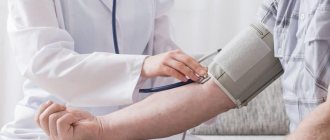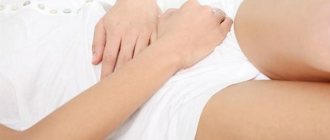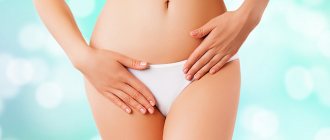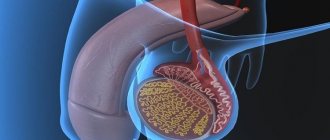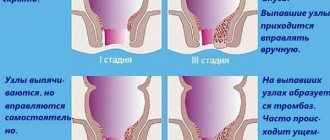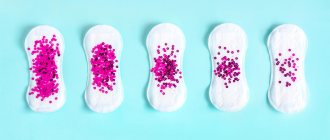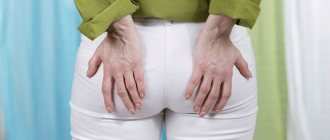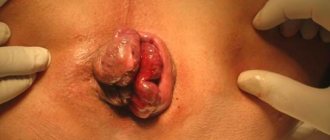The very name of the disease “hemorrhoids” is Greek. haima "blood" + rein "to flow" - indicates one of its main symptoms.
Bleeding from the anus occurs in the vast majority of patients. In this case, bleeding can occur both during bowel movements and completely unexpectedly. In any case, such a clinical picture requires immediate treatment of hemorrhoids.
It should be noted that bleeding is sometimes the only symptom of pathology. Therapeutic tactics for this group of patients are somewhat different than for other categories.
Features of hemorrhoidal bleeding:
- Bright scarlet color of blood.
- During hemorrhoidal bleeding, blood is released in drops.
- There are frequent cases of absence of pain syndrome.
Hemorrhoidal bleeding is divided into heavy and moderate. Abundant ones are of a regular nature, that is, they manifest themselves with every act of defecation. These are arterial bleedings released in splashes or streams. Blood can be seen on the walls of the toilet, on toilet paper, and in feces. Moderate bleeding is observed exclusively with constipation or due to a sudden change in diet.
Causes of bleeding from hemorrhoids
- Injury to hemorrhoids by too hard stool. As a rule, it occurs against the background of regular constipation.
- Regular diarrhea.
- Severe inflammation of the rectal mucosa.
- Pushing during childbirth.
Procto-Glivenol® is a modern, combined drug for the treatment of hemorrhoids
Procto-Glyvenol® reduces the incidence of bleeding from hemorrhoids thanks to tribenoside, does not contain hormones and antibiotics, is available in the form of suppositories or cream, which allows each patient to choose the most comfortable treatment.
More information about the drug
Types of bleeding and their elimination
Hemorrhoidal bleeding can be scanty or profuse.
Scanty bleeding is characterized by the appearance of several spots of blood on linen or paper after visiting the toilet.
Heavy bleeding begins with the loss of 1-2 ml of blood. But if left untreated, it can quickly progress to the stage of massive blood loss, which poses a great threat to health.
To eliminate bleeding, you need to wash yourself with cool, but not cold water, otherwise paraproctitis may be added to hemorrhoids. This brings instant relief as the inflamed nodes shrink in size, closing the outlet for blood.
After washing, it is necessary to apply an ointment that has anti-inflammatory and anticoagulating effects to the affected area.
At the initial stage of the disease, the use of such medications eliminates symptoms, and with advanced hemorrhoids, it alleviates the patient’s condition, reducing swelling of the anal mucosa, soothing pain and relieving burning.
Bleeding is a sign that a fissure has appeared in the anus. If no action is taken to treat hemorrhoids, over time it will be complicated by anemia, up to severe severity with hemoglobin less than 80 g/l, chronic reflex constipation, and can transform into a bleeding tumor.
Regardless of whether the bleeding is scanty or heavy, you must immediately consult a doctor! You can consult online with a therapist or proctologist.
Diagnostics
Even with a single bleeding from the anus, the patient urgently needs to consult a proctologist! In addition to the initial digital examination of the rectum, the diagnostic appointment ideally includes colonoscopy - an endoscopic examination of the large intestine.
The main goal of medical procedures is to exclude cancer.
Remember that timely diagnosis is much more effective than any expensive treatment in the later, advanced stages of the disease. Don't forget to monitor your health and don't lose sight of even the smallest problems!
Treatment of hemorrhoids accompanied by slight bleeding
To cope with the disease, it is important to find the right method of dealing with it. Some people benefit from diets and suppositories, while others need surgery.
At the first manifestations of the disease, you must adhere to simple rules of nutrition and hygienic care.
Diet food
Review your diet by eliminating everything fatty, fried, spicy, pickled, as well as desserts, coffee and alcohol.
The daily diet should include cereals (with the exception of semolina, rice and corn), soups with a mucous consistency, stale or dried bread, lean meat or dietary fish, steamed, drinking plenty of fluids (decoctions of berries and herbs, non-acidic natural juices).
Taking cool baths
As a bath, it is best to use decoctions of herbs with anti-inflammatory or astringent effects - chamomile, calendula, oak bark.
The decoction for each procedure must be freshly prepared and sufficiently cooled. You need to sit in it every day for 10-15 minutes. As an alternative to baths, wiping the anus with a piece of ice is used.
Replacing toilet paper by flushing
Since the main reason for non-healing of erosion in the anus is the entry of feces into the wound, they must be disposed of after each act of defecation by regular washing.
Use of topical medications
Ointments and suppositories will not cure on their own if the disease is advanced and progresses. But if used regularly at the initial stage, they can help.
A good remedy for bleeding hemorrhoids is suppositories with sea buckthorn oil.
How to stop bleeding
Relief Advance is an excellent suppository for hemorrhoids.
Stopping bleeding from hemorrhoids is an important matter that should not be put off. Also, do not forget that the mere fact of stopping hemorrhoidal bleeding is not at all a reason for refusing to seek help from a doctor. The most common over-the-counter drug that is effective only for very small bleeding is the drug Vikasol. If the problem does not stop within half an hour, you should apply ice and contact an ambulance. There are also several ways to combat bleeding using traditional medicine:
- calendula tincture lotions
- microenemas consisting of blueberry decoction, calendula tincture, wheatgrass rhizome and one percent tannin solution
- garlic steam
- candles made from infusions of medicinal herbs
Preventive measures that reduce the risk of problems occurring during bowel movements:
- special diet
- performing various exercises and playing sports
- use of hard furniture
- weight control
- washing with cold water after defecation
Hemorrhoidal bleeding is a symptom of hemorrhoids that appears as a result of damage to hemorrhoids - seals formed on the surface of the rectum. There are many methods to stop bleeding, but only a specialist can truly cure this disease. The doctor will prescribe a diet, necessary exercises and other measures to combat bleeding from hemorrhoids.
Treatment of hemorrhoids accompanied by heavy bleeding
When hemorrhoids are inflamed and enlarged, blood can flow in a stream not only when visiting the toilet, but also with any sudden movement or physical stress.
In this case, you need to take effective medications. Remember that only your attending physician can prescribe them, taking into account the course of the disease and the individual characteristics of the body.
Treatment methods for hemorrhoids with heavy bleeding:
- Taking tablet medications.
- The use of anti-inflammatory ointments and suppositories. Inexpensive candles (average price 50-120 rubles): Belladonna extract, Anuzol, Methyluracil, Betiol. The most effective (300-600r): Relief, Procto-glivenol, Ultraproct, Nigepan, Proctosan, Hepazolon. In some cases, injections of hemostatic drugs.
Doctor's advice
Everyone has heard that there is food that strengthens, and there is food that weakens. But people often confuse the properties of their usual food products. It is worth paying attention to the ability to produce gas - this can contribute to additional discomfort with hemorrhoids.
Victoria Druzhikina Neurologist, Therapist
- If there is a risk of anemia, take vitamins C and K, as well as preparations containing iron.
- Sclerotherapy using medications.
- Radical measures are surgery. It is used in cases where other methods do not produce results or their use is futile, the decision is made by the surgeon.
If you are in doubt about which candles to choose, consult your physician.
Causes of blood in stool
Stool with blood visible to the naked eye is most often observed with hemorrhoids, anal fissure, colorectal cancer and colitis. It is noteworthy that the nature of rectal bleeding in each of the listed diseases has certain differences.
Haemorrhoids
Inflammatory disease of the hemorrhoidal veins of the rectum, accompanied by expansion and thrombosis of the hemorrhoids.
Bloody discharge is usually scanty, bright scarlet or bright red. In rare cases, dark-colored blood or bloody clots are observed. Distinctive feature: blood is not mixed with feces.
Other symptoms of hemorrhoids: pain, itching, a feeling of fullness in the rectum, prolapse of hemorrhoids outward.
Anal fissure
Rupture of the mucous membrane of the anal canal, most often of traumatic origin.
The pattern of bleeding resembles the symptoms of hemorrhoids: scarlet or red blood, not mixed with feces. The amount of blood is usually small, although with large cracks the blood loss can be significant.
Other symptoms of anal fissure: pain during bowel movements, quickly subsiding after bowel movement; occasionally, if the gap is inflamed, there is a feeling of fullness.
Colorectal cancer
Malignant tumor of one or more parts of the colon.
The blood may be red or distinctly black. A distinctive feature: blood is released at the beginning of the act of defecation, and not at the end, as with hemorrhoids or anal fissure. In some cases, all excreted feces may become bloody in color.
Other symptoms of colorectal cancer: the presence of a large amount of mucus or pus in the stool, a specific smell of stool, pain in the abdomen, stool disorders, a feeling of incomplete bowel movement, flatulence, constant weakness and fatigue, sudden weight loss.
Ulcerative colitis
Inflammation of the mucous membrane of the large intestine with the formation of ulcerations (wounds).
Blood is always mixed with feces, but more often in the form of subtle inclusions or bloody mucus. In the later stages of the disease, blood or bloody mucus may be released even outside of bowel movements.
Other symptoms of ulcerative colitis: frequent and liquid stools, with a foul odor, sometimes mixed with pus; frequent urge to defecate; cramping pain in the abdomen, often on the left side; constant flatulence; general weakness and severe emaciation.
Other reasons
The presence of blood in the stool can also be observed in some other diseases:
- stomach and duodenal ulcers;
- Crohn's disease;
- intestinal polyps;
- syphilitic ulcers of the rectum;
- gonorrheal proctitis, etc.
A separate group of causes of bloody impurities in the stool includes various intestinal infectious diseases of a viral, bacterial or protozoal (parasitic) nature: dysentery, salmonellosis, botulism, enterovirus, rotavirus, cytomegalovirus, amoebiasis, etc. Each intestinal infection has its own specific clinical picture, but in general terms the course of development of most intestinal infections resembles ulcerative colitis.
Treatment of hemorrhoids during pregnancy
Every second woman suffering from inflammation of hemorrhoids developed this disease during the most wonderful period of her life - during pregnancy.
Developing in the mother's womb, the fetus affects blood circulation and intestinal function, causing various problems, including hemorrhoids. The disease may appear in the last months of pregnancy or after childbirth.
Factors that can trigger the appearance of hemorrhoids during pregnancy:
- weakness of the rectal muscles;
- tendency to constipation;
- abuse of fatty and spicy foods;
- increased physical activity.
To prevent the occurrence of hemorrhoids during pregnancy, three conditions must be met - avoidance of spicy foods, a minimum of physical activity and normalization of stool.
For mild hemorrhoidal inflammation, ointments, creams and suppositories are used, paying attention to their composition: the drugs should not have a toxic effect on the fetus.
The best option are candles:
- suppositories can be bought at any pharmacy without a prescription;
- suppositories have a complex effect - they not only relieve pain, but also help eliminate constipation and flatulence, eliminate unpleasant obsessive itching in the anus;
- are easy to use and allow a woman to take care of herself independently, even in the last months of pregnancy, when medical procedures are complicated by a protruding belly.
What measures should be taken if medication methods do not help?
The conservative method of therapy is relatively effective in the early stages of the disease or for preventive measures of chronic forms of the disease. At stages 3 and 4 with pronounced symptoms, this therapy will be ineffective, because the dynamics of the development of hemorrhoids requires a deeper intervention. If the dynamics after 2 weeks of therapy are zero, then you should consult a doctor to review the therapeutic tactics.
The further format of work with the patient will depend on the severity of the disease and the characteristics of the patient’s body. Today, there are many minimally invasive techniques that do not involve full-scale surgical intervention, are low-traumatic and do not violate the integrity of the skin.
Medicinal herbs for the treatment of hemorrhoids
Our grandmothers also used herbs with enveloping, anti-inflammatory and astringent effects to treat hemorrhoids, which are very effective for use at home.
To the already mentioned chamomile, calendula and oak bark, you can add yarrow, blueberries, and wheatgrass root. Decoctions from these plants are suitable for both baths and mini-enemas.
Aloe juice has a therapeutic effect in the fight against hemorrhoids, preventing inflammation and healing cracks. All herbs should be started at low concentrations to avoid possible allergic reactions if tolerance to a particular herb is unknown.
Juice and gruel from raw potatoes are used with great success in the treatment of hemorrhoids. Potatoes can stop bleeding, speed up the healing of cracks, and restore the condition of the rectal mucosa.
Hemorrhoids are a very unpleasant disease that causes discomfort. As the disease progresses, bleeding may occur. To avoid this, do not start the disease, but at the first symptoms, contact a specialist who will prescribe effective treatment, taking into account all the characteristics of your body.
Characteristics of the disease
Hemorrhoids are a pathological enlargement of the vascular plexuses (corpora cavernosa) of the submucosal layer of the rectum with the formation of hemorrhoids, which is accompanied by their prolapse from the anal canal, frequent inflammation and bleeding.
Predisposing factors in the development of hemorrhoids are:
- Sedentary lifestyle.
- Obesity.
- Alcohol abuse, smoking.
- Poor nutrition: predominance of spicy, fatty, fried foods in the menu, non-compliance with diet, deficiency of plant fiber in food.
- Prolonged diarrhea due to irritable bowel syndrome.
- Pregnancy and childbirth.
- Frequent use of enemas, laxatives, douching.
- Physical overload, prolonged static load on the legs (salesmen, hairdressers), some sports: weightlifting, cycling, horse riding.
- Chronic constipation.
Under such conditions, intra-abdominal pressure increases, blood stagnates in the corpora cavernosa, they expand, increase in size, and become deformed, turning into hemorrhoids.
Diseases such as portal hypertension and pelvic tumors can lead to secondary hemorrhoids.
The main thing in the prevention of hemorrhoids is the elimination or reduction of the number of provoking factors.
Product table
| The product's name | Fastens | Weakens | Gives gas formation |
| Cabbage | + | + | |
| Whole milk | + | + | |
| Sour milk | + | ||
| Beet | + | ||
| Bakery | + | ||
| Peas | + | ||
| Egg | + | ||
| Semolina | + | ||
| Cream | + | ||
| Potato | + | ||
| Fatty meat | + | + | |
| Plum | + | ||
| Chokeberry | + | ||
| Pear | + | ||
| Black bread | + | ||
| Rice | + | ||
| Pomegranate | + | ||
| Apricot | + | ||
| Persimmon | + | ||
| Black tea | + | ||
| Walnut | + |
Find out about the most effective candles from the video:
This article has been verified by a current qualified physician, Victoria Druzhikina, and can be considered a reliable source of information for site users.
Bibliography
1. https://www.gastroscan.ru/literature/authors/9497
Rate how useful this article was
4.4 18 people voted, average rating 4.4
Did you like the article? Save it to your wall so you don’t lose it!
Classification of painkillers by release form
Hemorrhoids are a well-studied problem, so prevention and treatment methods always guarantee a good result. Despite the wide selection of drugs in pharmacies, only the attending physician can prescribe complex therapy after a thorough diagnosis of the problem. The form of release of drugs is selected depending on the individual preferences of the patient and the complexity of the symptoms. The most effective and acceptable forms of drug release are suppositories, ointments and tablets.
Candles
In an acute inflammatory process, it is extremely difficult to anesthetize a pronounced pain syndrome, because First you need to stop the swelling. Many proctologists advise the use of local anesthetics, which simultaneously relieve inflammation, relieve pain and promote the regeneration of anal fissures. The main advantages of local drugs:
- Minimum contraindications and side effects;
- Acts directly on the source of inflammation;
- Effective rate of absorption and symptom relief.
Unlike tablets, suppositories are used only for internal hemorrhoids. The neurotropic principle of action of the drug allows you to relieve pain by blocking the conduction of nerve impulses from the location of the “bumps” to the neurons of the brain.
Ointments and gels
Used for external and internal hemorrhoids. The main advantages of the drugs are ease of use, uniform distribution of the active substance and high absorption rate. The analgesic effect is achieved by relieving swelling and inflammation, narrowing the vessels of varicose veins, regenerating cracks and the antibacterial effect of the ointment. Among the names of popular products are Proctosan, Relief Advance, Proctosedyl.
Painkillers for hemorrhoids
Efficient and effective systemic drugs in the fight against the symptoms of hemorrhoids are venotonic and agnioprotective tablets. According to the principle of action, drugs can be divided into 2 types:
- Tablets that have only an analgesic effect. Their action is aimed at reducing painful symptoms. Painkillers have many contraindications, and the course of treatment cannot exceed several days.
- Systemic tablets with a dose-dependent effect can not only relieve attacks of pain, but also have a beneficial effect on the general condition of blood vessels. They affect the cause of the disease, increase venous tone, improve lymphatic drainage, increase vascular stability, thereby reducing inflammation of the nodes. Effective healing of cracks and microtraumas of the anal mucosa is achieved due to its regenerating properties. The most recommended tablets from this group are called “Phlebodia” and “Detralex”.
Before diagnosing yourself and treating the symptoms of the disease, you should consult a proctologist. Many drugs have contraindications and a special dosage regimen, without taking into account which you can harm your health and aggravate the course of the disease.
